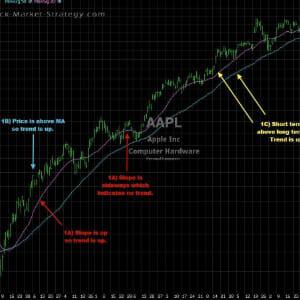The other day I were talking with a trader about his day trading and he was showing me some charts. I noticed he was using several leading indicators which we have previously warned about. So we decided to create a new video explaining the different indicators that exist. Not MACD or Stochastic but the different types; Lagging, Leading and Confirming Indicators.
It is important to understand the different types before implementing technical indicators into your trading. The indicators itself are just tools to use in your trading but you have to understand how to group them together for higher odds of success.
The 3 Different Types Of Indicators
Lagging indicators is best used for the overall picture. They are great to filter out noise and provide the trader with an idea of trend. The most common lagging indicator is the Moving Average. Long term members of Stock Market Strategy are well aware of our "affection" of the Moving Average. It plays a vital role in our Phase Analysis. We also use it for reference points to determine potential turning points before a break of the Moving Average.
Leading indicators are called that because they try to predict price by using a shorter period in their calculation however do not get fooled by the name. They are still lagging just not as much. Leading indicators are used for entries which is probable why traders tend to use them too much. Many traders focus on the entries instead of the analysis. Most popular leading indicators are Stochastic, MACD and RSI.
Confirming indicators are used to "confirm" an entry signal by for example using volume. Confirming indicators as a stand alone is pretty weak but they are useful to improve the odds of success by filtering out some of the fake signals. By removing perhaps 10% of your losing trading you are improving your bottom line.
How To Use All 3 Types Of Technical Indicators
An example of how to put this to work is for example by using a Moving Average to determine the trend. This is called a filter. You are filtering out the weaker trades and in this case it would be the counter trend trades. The Moving Average would also prevent you from trading chop and sideways price action. A great use of an indicator from the group “lagging indicators”.
Next you will be looking for an indicator that can help you enter a trade in congruence with the above “lagging indicator”. So if your Moving Average showed an uptrend you would then look for a long entry. One way to do that is by using Stochastic. So when Stochastic is oversold, which means a retracement in an uptrend, a buy order can be placed. You have now combined a “lagging indicator” with a “leading indicator”. Notice how they compliment each other and not substitute each other.
Last but not least you can use a “confirming indicator”. Because we are trading a trend (determined by our Moving Average) it could be smart to use the ADX - Average Directional Index. This “confirming indicator” helps you gauge the strength of a trend. Basically telling you the trend is valid and strong enough for you to buy the dips using Stochastic.
I have seen many traders learn about an indicator and believe they now know all they need to know for them to become profitable trading the stock market. Do not make that same mistake. Learn what indicators are and why you would choose one indicator instead of another.
